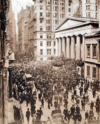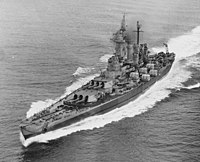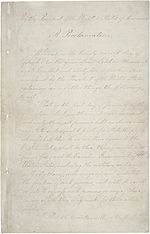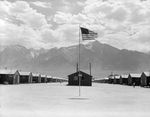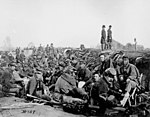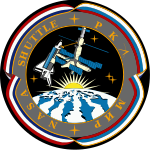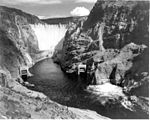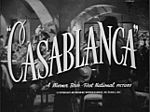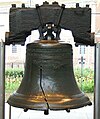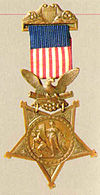Selected article
</noinclude>
Instructions
- Use template {{Portal:United States/Selected article/Layout}}.
- Add a new Selected article to the next available subpage.
Selected articles list
1–25
Selected article 1
</noinclude> Portal:United States/Selected article/1 The United States' multi-ethnic population is reflected through a diverse array of styles of music. It is a mixture of music influenced by the music of Europe, Indigenous peoples, West Africa, Latin America, Middle East, North Africa, amongst many other places. The country's most internationally renowned genres are traditional pop, jazz, blues, country, bluegrass, rock, rock and roll, R&B, pop, hip-hop/rap, soul, funk, religious, disco, house, techno, ragtime, doo-wop, folk, americana, boogaloo, tejano, surf, and salsa, amongst many others. American music is heard around the world. Since the beginning of the 20th century, some forms of American popular music have gained a near global audience. (Full article...)
Selected article 2
</noinclude> Portal:United States/Selected article/2
The Girl Scouts of the United States of America (GSUSA) is a youth organization for girls in the United States and American girls living abroad. The Girl Scout program, which developed from the concerns of the progressive movement in the United States, sought to promote the social welfare of young ladies and was formed as a counterpart to the Boy Scouts of America (BSA). It was founded by Juliette Gordon Low in 1912 and is based on the Scouting principles developed by Robert Baden-Powell.The GSUSA uses the Scout method to build self-esteem and to teach values such as honesty, fairness, courage, compassion, character, sisterhood, confidence, and citizenship through activities including camping, community service, learning first aid, and earning numerous badges by acquiring other practical skills. Girl Scouts' achievements are recognized through rank advancement and by various special awards. GSUSA has programs for girls with special interests, such as water-based activities.
Membership is organized according to age group with activities designed appropriately for each level. The GSUSA is a member of the World Association of Girl Guides and Girl Scouts (WAGGGS), and has a long history of accepting girls from all backgrounds.
Selected article 3
</noinclude> Portal:United States/Selected article/3
The Panic of 1907 was a financial crisis that occurred in the United States when its stock market fell close to 50 percent from its peak the previous year. Primary causes of the run included a retraction of market liquidity by a number of New York City banks, a loss of confidence among depositors, and the absence of a statutory lender of last resort. The crisis occurred after the failure of an attempt in October 1907 to corner the market on stock of the United Copper Company. When this bid failed, banks that had lent money to the cornering scheme suffered runs which later spread to affiliated banks and trusts, leading a week later to the downfall of the Knickerbocker Trust Company—New York City's third-largest trust. The collapse of the Knickerbocker spread fear throughout the city's trusts as regional banks withdrew reserves from New York City banks. The panic would have deepened if not for the intervention of financier J.P. Morgan, who pledged large sums of his own money, and convinced other New York bankers to do the same, to shore up the banking system. By November the contagion had largely ended. The following year, Senator Nelson W. Aldrich established and chaired a commission to investigate the crisis and propose future solutions, leading to the creation of the Federal Reserve System.Selected article 4
</noinclude> Portal:United States/Selected article/4
Yellowstone National Park, set aside as a national park on March 1, 1872, is located mostly in the U.S. state of Wyoming, though it also extends into Montana and Idaho. The park was the first of its kind, and is known for its wildlife and geothermal features, especially Old Faithful Geyser, one of the most popular areas in the park.Aside from visits by mountain men during the early to mid-1800s, organized exploration did not begin until the late 1860s. The U.S. Army was commissioned to oversee the park just after its establishment. In 1917, administration of the park was transferred to the National Park Service, which had been created the previous year. Hundreds of structures have been built and are protected for their architectural and historical significance, and researchers have examined more than 1,000 archaeological sites.
Yellowstone National Park spans an area of 3,472 square miles (8,987 km²), comprising lakes, canyons, rivers and mountain ranges. Yellowstone Lake is one of the largest high-altitude lakes in North America and is centered over the Yellowstone Caldera, the largest supervolcano on the continent. Half of the world's geothermal features are in Yellowstone, fueled by this ongoing volcanism. The park is the centerpiece of the Greater Yellowstone Ecosystem, the largest remaining, nearly-intact ecosystem in the Earth's northern temperate zone.
Hundreds of species of mammals, birds, fish and reptiles have been documented. The vast forests and grasslands also include unique species of plants. Grizzlies, wolves, and free-ranging herds of bison and elk live in the park. Forest fires occur in the park each year; in the large forest fires of 1988, nearly one third of the park burned. Yellowstone has numerous recreational opportunities, including hiking, camping, boating, fishing and sightseeing. Paved roads provide close access to the major geothermal areas as well as some of the lakes and waterfalls. During the winter, visitors often access the park by way of guided tours that use either snow coaches or snowmobile.
Selected article 5
</noinclude> Portal:United States/Selected article/5
The North Carolina class was a group of two fast battleships, North Carolina and Washington, built for the United States Navy in the late 1930s and early 1940s. The navy was originally uncertain whether the ships should be fast enough to counter the Japanese Kongō class, which was believed by the United States to be capable of 26 knots (30 mph; 48 km/h), or should sacrifice speed for additional firepower and armor. The Second London Naval Treaty's requirement that all capital ships have a standard displacement of under 35,000 long tons (35,560 metric tons (t)) meant that the desired objectives could not be fully realized within the treaty limits, and the navy considered over fifty designs before one was chosen.Both North Carolina and Washington saw extensive service during World War II in a variety of roles, primarily in the Pacific theater. North Carolina frequently acted as an escort for the fast carrier task forces, and also conducted shore bombardments. In 1942, during the naval battle of Guadalcanal, Washington heavily damaged the Japanese battleship Kirishima in a chaotic night engagement; Kirishima had to be scuttled the next day. She also served as a carrier escort. In February 1943, she collided with the battleship Indiana and suffered severe damage to her bow. Following repairs, Washington rejoined her sister for the Battle of the Philippine Sea. After the end of the war, both ships took part in Operation Magic Carpet, the withdrawal of American military personnel from overseas deployments. The vessels were laid up in the reserve fleet until the early 1960s, when North Carolina was sold to her home state as a museum ship, and Washington was broken up for scrap.
Selected article 6
</noinclude> Portal:United States/Selected article/6
African American history is the portion of American history that specifically discusses the African American or Black American ethnic group in the United States. Most African Americans are the descendants of captive Africans held in the United States from 1619 to 1865. Blacks from the Caribbean whose ancestors immigrated, or who immigrated to the U.S., also traditionally have been considered African American, as they share a common history of predominantly West African or Central African roots, the Middle Passage and slavery.It is these peoples, who in the past were referred to and self-identified collectively as the American Negro, who now generally consider themselves African Americans. It is these peoples whose history is celebrated and highlighted annually in the United States during February, designated as Black History Month, and it is their history that is the focus of this article.
Others who sometimes are referred to as African Americans, and who may self-identify as such in US government censuses, include relatively recent Black immigrants from Africa, South America and elsewhere who self-identify as being of African descent.
Selected article 7
</noinclude> Portal:United States/Selected article/7
The flag of the United States of America consists of 13 equal horizontal stripes of red (top and bottom) alternating with white, with a blue rectangle in the canton bearing 50 small, white, five-pointed stars arranged in nine offset horizontal rows of six stars (top and bottom) alternating with rows of five stars.The 50 stars on the flag represent the 50 U.S. states and the 13 stripes represent the original Thirteen Colonies that rebelled against the British crown and became the first states in the Union.[1] Nicknames for the flag include the Stars and Stripes, Old Glory,[2] and the Star-Spangled Banner (also the name of the country's official national anthem).
Because of its symbolism, the starred blue canton is called the "union". This part of the national flag can stand alone as a maritime flag called the Union Jack[3] which served as the U.S. jack on warships from 1777 until 2002. It continues to be used as a jack by various federally-owned vessels, including those of the Coast Guard, Military Sealift Command, and National Oceanic and Atmospheric Administration.
Selected article 8
</noinclude> Portal:United States/Selected article/8
Plymouth Colony was an English colonial venture in North America from 1620 until 1691. The first settlement was at New Plymouth, a location previously surveyed and named by Captain John Smith. The settlement, which served as the capital of the colony, is today the modern town of Plymouth, Massachusetts. At its height, Plymouth Colony occupied most of the southeastern portion of the modern state of Massachusetts.Founded by a group of separatists who later came to be known as the Pilgrims, Plymouth Colony was, along with Jamestown, Virginia, one of the earliest colonies to be founded by the English in North America and the first sizable permanent English settlement in the New England region. Aided by Squanto, a Native American, the colony was able to establish a treaty with Chief Massasoit which helped to ensure the colony's success. The colony played a central role in King Philip's War, one of the earliest and bloodiest of the Indian Wars. Ultimately, the colony was annexed by the Massachusetts Bay Colony in 1691.
Plymouth holds a special role in American history. Rather than being entrepreneurs like many of the settlers of Jamestown, the citizens of Plymouth were fleeing religious persecution and searching for a place to worship God as they saw fit. The social and legal systems of the colony were thus closely tied to their religious beliefs. Many of the people and events surrounding Plymouth Colony have become part of American mythology, including the North American tradition known as Thanksgiving and the monument known as Plymouth Rock. Despite the colony's relatively short history, it has become an important symbol of what is now labeled "American", owing largely to its treatment in American public schools.
Selected article 9
</noinclude> Portal:United States/Selected article/9
Manzanar is most widely known as the site of one of ten internment camps where over 110,000 Japanese Americans were imprisoned during World War II. Located at the foot of the Sierra Nevada in California's Owens Valley between the towns of Lone Pine to the south and Independence to the north, it is approximately 230 miles (370.1 km) northeast of Los Angeles. Manzanar (which means "apple orchard" in Spanish) was identified by the United States National Park Service as the best-preserved of the former camp sites, and it is now the Manzanar National Historic Site.Long before the first prisoners arrived in March 1942, Manzanar was home to Native Americans, who mostly lived in villages near several creeks in the area, and then to the ranchers and miners who established the town of Manzanar in 1910, but had abandoned the town by 1929 after the City of Los Angeles purchased the water rights to virtually the entire area. As different as these groups might seem, they are tied together by the common thread of forced relocation.
Selected article 10
</noinclude> Portal:United States/Selected article/10
The United States Constitution is the supreme law of the United States of America. It was adopted on September 17, 1787, by the Constitutional Convention in Philadelphia, Pennsylvania, and later ratified by conventions in each state in the name of "the People"; it has since been amended seventeen times, besides the 10 added through the Bill of Rights. The Constitution has a central place in United States law and political culture. The handwritten, or "engrossed", original document is on display at the National Archives and Records Administration in Washington, D.C. The United States Constitution has 4,543 words, including the signatures.Several of the ideas in the Constitution were new, and a large number of ideas were drawn from the literature of Republicanism in the United States, from the experiences of the 13 states, and from the British experience with mixed government. The most important influence from the European continent was from Montesquieu, who emphasized the need to have balanced forces pushing against each other to prevent tyranny.
Selected article 11
</noinclude> Portal:United States/Selected article/11
The American Civil War was a civil war in the United States of America. Eleven Southern slave states declared their secession from the U.S., formed the Confederate States of America and fought against the U.S. federal government.Hostilities began on April 12, 1861, when Confederate forces attacked a U.S. military installation at Fort Sumter in South Carolina. In the war's first year, the Union assumed control of the border states and established a naval blockade as both sides massed armies and resources. In 1862, battles such as Shiloh and Antietam caused massive casualties unprecedented in U.S. military history.
In the East, Confederate commander Robert E. Lee won a series of victories, but Lee's loss at Gettysburg in July, 1863 proved the turning point. Union commander Ulysses S. Grant fought bloody battles of attrition with Lee in 1864, forcing Lee to defend the Confederate capital at Richmond, Virginia. Union general William Sherman captured Atlanta, Georgia, and began his famous March to the Sea. Confederate resistance collapsed after Lee surrendered to Grant at Appomattox on April 9, 1865.
The war caused 620,000 soldier deaths and an undetermined number of civilian casualties, ended slavery in the United States, restored the Union and strengthened the role of the federal government.
Selected article 12
</noinclude> Portal:United States/Selected article/12
7 World Trade Center (7 WTC, WTC-7, or Tower 7) is an office building constructed as part of the new World Trade Center in Lower Manhattan, New York City. The tower is located on a city block bounded by Greenwich, Vesey, Washington, and Barclay Streets on the east, south, west, and north, respectively. 7 World Trade Center was developed by Larry Silverstein, who holds a ground lease for the site from the Port Authority of New York and New Jersey, and designed by Skidmore, Owings & Merrill.The building was constructed to replace the original structure on the site, part of the original World Trade Center. The previous structure, completed in 1987, was destroyed in the September 11 attacks in 2001. Construction of the new 7 World Trade Center began in 2002 and was completed on May 23, 2006. The building is 52 stories tall (plus one underground floor), making it the 64th-tallest in New York. It is built on a smaller footprint than the original; a small park across Greenwich Street occupies space that was part of the original building's footprint.
The current building's design emphasizes safety, with a reinforced concrete core, wider stairways, and thicker fireproofing on steel columns. It also incorporates numerous green design features. The building received the U.S. Green Building Council's Leadership in Energy and Environmental Design (LEED) Gold certification and was part of the council's pilot program for Leadership in Energy and Environmental Design – Core and Shell Development (LEED-CS). (Full article...)
Selected article 13
</noinclude> Portal:United States/Selected article/13
The Shuttle–Mir Program was a collaborative space program between Russia and the United States, which involved American Space Shuttles visiting the Russian space station Mir, Russian cosmonauts flying on the shuttle and an American astronaut flying aboard a Soyuz spacecraft to engage in long-duration expeditions aboard Mir.The project, sometimes called "Phase One", was intended to allow the United States to learn from Russian experience with long-duration spaceflight and to foster a spirit of cooperation between the two nations and their space agencies, the US National Aeronautics and Space Administration (NASA) and the Russian Federal Space Agency (Roskosmos). The project helped to prepare the way for further cooperative space ventures; specifically, "Phase Two" of the joint project, the construction of the International Space Station (ISS). The program was announced in 1993, the first mission started in 1994 and the project continued until its scheduled completion in 1998. Eleven Space Shuttle missions, a joint Soyuz flight and almost 1000 cumulative days in space for American astronauts occurred over the course of seven long-duration expeditions.
During the four-year program, many firsts in spaceflight were achieved by the two nations, including the first American astronaut to launch aboard a Soyuz spacecraft, the largest spacecraft ever to have been assembled at that time in history, and the first American spacewalk using a Russian Orlan spacesuit.
The program was marred by various concerns, notably the safety of Mir following a fire and a collision, financial issues with the cash-strapped Russian Space Program and worries from astronauts about the attitudes of the program administrators. Nevertheless, a large amount of science, expertise in space station construction and knowledge in working in a cooperative space venture was gained from the combined operations, allowing the construction of the ISS to proceed much more smoothly than would have otherwise been the case.
Selected article 14
</noinclude> Portal:United States/Selected article/14
The Statue of Liberty (Liberty Enlightening the World [French: La Liberté éclairant le monde]) is a colossal neoclassical sculpture on Liberty Island in New York Harbor, designed by Frédéric Bartholdi and dedicated on October 28, 1886. The statue, a gift to the United States from the people of France, is of a robed female figure representing Libertas, the Roman goddess of freedom, who bears a torch and a tabula ansata (a tablet evoking the law) upon which is inscribed the date of the American Declaration of Independence. A broken chain lies at her feet. The statue has become an iconic symbol of freedom and of the United States.The statue was administered by the United States Lighthouse Board until 1901 and then by the Department of War; since 1933 it has been maintained by the National Park Service. The statue was closed for renovation for much of 1938. In the early 1980s, it was found to have deteriorated to such an extent that a major restoration was required. While the statue was closed from 1984 to 1986, the torch and a large part of the internal structure were replaced. After the September 11 attacks in 2001, it was closed for reasons of safety and security; the pedestal reopened in 2004 and the statue in 2009, with limits on the number of visitors allowed to ascend to the crown. The statue is scheduled to close for up to a year beginning in late 2011 so that a secondary staircase can be installed. Public access to the balcony surrounding the torch has been barred for safety reasons since 1916.
Selected article 15
</noinclude> Portal:United States/Selected article/15
World War II or the Second World War (often abbreviated as WWII or WW2), was a global military conflict lasting from 1939 to 1945, which involved most of the world's nations, including all of the great powers: eventually forming two opposing military alliances, the Allies and the Axis. It was the most widespread war in history, with more than 100 million military personnel mobilised. In a state of "total war," the major participants placed their entire economic, industrial, and scientific capabilities at the service of the war effort, erasing the distinction between civilian and military resources. Marked by significant events involving the mass death of civilians, including the Holocaust and the only use of nuclear weapons in warfare, it was the deadliest conflict in human history, resulting in 50 million to over 70 million fatalities.The war ended with the total victory of the Allies over Germany and Japan in 1945. World War II altered the political alignment and social structure of the world. The United Nations (UN) was established to foster international cooperation and prevent future conflicts (such as World War III). The Soviet Union and the United States emerged as rival superpowers, setting the stage for the Cold War, which would last for the next 46 years. Meanwhile, the influence of European great powers started to decline, while the decolonization of Asia and Africa began. Most countries whose industries had been damaged moved towards economic recovery. Political integration emerged as an effort to stabilise postwar relations.
Selected article 16
</noinclude> Portal:United States/Selected article/16
The known history of the Grand Canyon area stretches back 10,500 years, when the first evidence of human presence in the area is found. Native Americans have inhabited the Grand Canyon and the area now covered by Grand Canyon National Park for at least the last 4,000 of those years. Anasazi, first as the Basketmaker culture and later as the more familiar Puebloans, developed from the Desert Culture as they became less nomadic and more dependent on agriculture. A similar culture, the Cohonina, also lived in the canyon area. Drought in the late 13th century likely caused both groups to move on. Other peoples followed, including the Paiute, Cerbat, and the Navajo, only to be later forced onto reservations by the United States Government.Early residents soon realized that tourism was destined to be more profitable than mining, and by the turn of the 20th century the Grand Canyon was a well-known tourist destination. Most visitors made the grueling trip from nearby towns to the South Rim by stagecoach. Although first afforded federal protection in 1893 as a forest reserve and later as a U.S. National Monument, the Grand Canyon did not achieve U.S. National Park status until 1919, three years after the creation of the National Park Service. Today, Grand Canyon National Park receives about five million visitors each year, a far cry from the annual visitation of 44,173 in 1919.
Selected article 17
</noinclude> Portal:United States/Selected article/17
Hoover Dam, once known as Boulder Dam, is a concrete arch-gravity dam in the Black Canyon of the Colorado River, on the border between the US states of Arizona and Nevada. It was constructed between 1931 and 1936 during the Great Depression, and was dedicated on September 30, 1935, by President Franklin Roosevelt. Its construction was the result of a massive effort involving thousands of workers, and cost over one hundred lives.Hoover Dam impounds Lake Mead, and is located near Boulder City, Nevada, a municipality originally constructed for workers on the construction project, about 25 mi (40 km) southeast of Las Vegas, Nevada. The dam's generators provide power for public and private utilities in Nevada, Arizona, and California. Hoover Dam is a major tourist attraction; nearly a million people tour the dam each year. Heavily travelled U.S. 93 ran along the dam's crest until October 2010, when the Hoover Dam Bypass opened.
Selected article 18
</noinclude> Portal:United States/Selected article/18
Chaco Culture National Historical Park is a United States National Historical Park hosting the densest and most exceptional concentration of pueblos in the American Southwest. The park is located in northwestern New Mexico, between Albuquerque and Farmington, in a remote canyon cut by the Chaco Wash. Containing the most sweeping collection of ancient ruins north of Mexico, the park preserves one of the United States' most important precolumbian cultural and historic areas.Composing a UNESCO World Heritage Site located in the arid and sparsely populated Four Corners region, the Chacoan cultural sites are fragile; fears of erosion caused by tourists have led to the closure of Fajada Butte to the public. The sites are considered sacred ancestral homelands by the Hopi and Pueblo people, who maintain oral accounts of their historical migration from Chaco and their spiritual relationship to the land. Though park preservation efforts can conflict with native religious beliefs, tribal representatives work closely with the National Park Service to share their knowledge and respect the heritage of the Chacoan culture.
Selected article 19
</noinclude> Portal:United States/Selected article/19
Casablanca is a 1942 American romantic drama film directed by Michael Curtiz, starring Humphrey Bogart, Ingrid Bergman and Paul Henreid, and featuring Claude Rains, Conrad Veidt, Sydney Greenstreet, Peter Lorre and Dooley Wilson. Set during World War II, it focuses on a man torn between, in the words of one character, love and virtue. He must choose between his love for a woman and helping her and her Czech Resistance leader husband escape from the Vichy-controlled Moroccan city of Casablanca to continue his fight against the Nazis.Although it was an A-list film, with established stars and first-rate writers—Julius J. Epstein, Philip G. Epstein and Howard Koch received credit for the screenplay—no one involved with its production expected Casablanca to be anything out of the ordinary; it was just one of dozens of pictures produced by Hollywood every year. The film was a solid, if unspectacular, success in its initial run, rushed into release to take advantage of the publicity from the Allied invasion of North Africa a few weeks earlier. Despite a changing assortment of screenwriters frantically adapting an unstaged play and barely keeping ahead of production, and Bogart attempting his first romantic lead role, Casablanca won three Academy Awards, including Best Picture. Its characters, dialogue, and music have become iconic, and Casablanca has grown in popularity to the point that it now consistently ranks near the top of lists of the greatest films of all time.
Selected article 20
</noinclude> Portal:United States/Selected article/20
"Amazing Grace" is a Christian hymn written by English poet and clergyman John Newton (1725–1807), published in 1779. With a message that forgiveness and redemption are possible regardless of the sins people commit and that the soul can be delivered from despair through the mercy of God, "Amazing Grace" is one of the most recognizable songs in the English-speaking world.Newton wrote the words from personal experience. He grew up without any particular religious conviction but his life's path was formed by a variety of twists and coincidences that were often put into motion by his recalcitrant insubordination. He was pressed into the Royal Navy and became a sailor, eventually participating in the slave trade. One night a terrible storm battered his vessel so severely that he became frightened enough to call out to God for mercy, a moment that marked the beginning of his spiritual conversion. His career in slave trading lasted a few years more until he quit going to sea altogether and began studying theology.
Author Gilbert Chase writes that "Amazing Grace" is "without a doubt the most famous of all the folk hymns", and Jonathan Aitken, a Newton biographer, estimates that it is performed about 10 million times annually. It has had particular influence in folk music, and become an emblematic African American spiritual. Its universal message has been a significant factor in its crossover into secular music. "Amazing Grace" saw a resurgence in popularity in the U.S. during the 1960s and has been recorded thousands of times during and since the 20th century, sometimes appearing on popular music charts.
Selected article 21
</noinclude> Portal:United States/Selected article/21
The Red Badge of Courage is a war novel by American author Stephen Crane. Taking place during the American Civil War, the story is about a young private of the Union Army, Henry Fleming, who flees from the field of battle. Overcome with shame, he longs for a wound—a "red badge of courage"—to counteract his cowardice. When his regiment once again faces the enemy, Henry acts as standard-bearer. Although Crane was born after the war, and had not at the time experienced battle firsthand, the novel is known for its realism. He began writing what would become his second novel in 1893, using various contemporary and written accounts (such as those published previously by Century Magazine) as inspiration. It is believed that he based the fictional battle on that of Chancellorsville; he may also have interviewed veterans of the 124th New York Volunteer Infantry Regiment, commonly known as the Orange Blossoms. Initially shortened and serialized in newspapers in December 1894, the novel was published in full in October 1895. Several of the themes that the story explores are maturation, heroism, cowardice, and the indifference of nature. Adapted several times for the screen, the novel became a bestseller. It has never been out of print, and is now thought to be Crane's most important work and a major American text.Selected article 22
</noinclude> Portal:United States/Selected article/22
American Airlines Flight 77 was a passenger flight which was hijacked by five al-Qaeda terrorists on September 11, 2001, as part of the September 11 attacks. They deliberately crashed it into the Pentagon near Washington, D.C., killing all 59 people on board plus the hijackers, as well as 125 people in the building. The aircraft involved, a Boeing 757-223, was flying American Airlines' daily scheduled morning transcontinental service from Washington Dulles International Airport, in Dulles, Virginia to Los Angeles International Airport in Los Angeles, California.Less than 35 minutes into the flight, the hijackers stormed the cockpit and forced the passengers to the rear of the aircraft. Hani Hanjour, one of the hijackers who was trained as a pilot, assumed control of the flight. Unknown to the hijackers, passengers aboard were able to make telephone calls to loved ones and relay information on the hijacking.
The aircraft crashed into the western side of the Pentagon at 09:37 EDT. Dozens of people witnessed the crash and news sources began reporting on the incident within minutes. The impact severely damaged an area of the Pentagon and caused a large fire. A portion of the Pentagon collapsed; firefighters spent days trying to fully extinguish the blaze. The damaged sections of the Pentagon were rebuilt in 2002, with occupants moving back into the completed areas on August 15, 2002.
The 184 victims of the attack are memorialized in the Pentagon Memorial adjacent to the Pentagon. The 1.93-acre (7,800 m2) park contains a bench for each of the victims, arranged according to their year of birth, ranging from 1930 (age 71) to 1998 (age 3).
Selected article 23
</noinclude> Portal:United States/Selected article/23
The 1996 U.S. campaign finance scandal refers to alleged efforts by the People's Republic of China to influence domestic United States politics prior to and during the Bill Clinton Administration as well as the fundraising practices of the administration itself. While questions regarding the U.S. Democratic Party's fundraising activities first arose in October 1996, the PRC's alleged role in the affair first gained public attention after Bob Woodward and Brian Duffy of the Washington Post published a story stating that a United States Department of Justice investigation into the fundraising activities had discovered evidence that agents of the PRC sought to direct contributions from foreign sources to the Democratic National Committee before the 1996 presidential campaign. The journalists wrote that intelligence information had shown the PRC Embassy in Washington, D.C. was used for coordinating contributions to the DNC in violation of United States law forbidding non-American citizens from giving monetary donations to United States politicians and political parties. Seventeen people were eventually convicted for fraud or for funneling Asian funds into the United States elections. A number of the convictions came against long-time Clinton-Gore friends and political appointees.Selected article 24
</noinclude> Portal:United States/Selected article/24
United Airlines Flight 93 was a scheduled U.S. domestic passenger flight from Newark International Airport, in Newark, New Jersey, to San Francisco International Airport. It was hijacked in 2001 by four men as part of the September 11 attacks. Over 40 minutes into the flight the hijackers breached the cockpit, overpowered the pilots and took over control of the aircraft, diverting it toward Washington, D.C. Several passengers and crew members made telephone calls aboard the flight and learned about the attacks on the World Trade Center and the Pentagon. As a result, the passengers decided to mount an assault against the hijackers and wrest control of the aircraft. The plane crashed in a field just outside Shanksville, Pennsylvania, about 150 miles (240 km) northwest of Washington, D.C., killing all 44 people aboard, including the hijackers. The plane fragmented upon impact, leaving a crater, and some debris was blown miles from the crash site. The remains of everyone on board the aircraft were later identified. Subsequent analysis of the flight recorders revealed how the actions taken by the passengers prevented the aircraft from reaching either the White House or United States Capitol. A permanent memorial is planned for construction on the crash site. The chosen design has been the subject of criticism and is scheduled to be dedicated in 2011.Selected article 25
</noinclude> Portal:United States/Selected article/25
Microsoft is an American multinational corporation headquartered in Redmond, Washington that develops, manufactures, licenses and supports a wide range of products and services related to computing. The company was founded by Bill Gates and Paul Allen on April 4, 1975. Microsoft was established to develop and sell BASIC interpreters for the Altair 8800. It rose to dominate the personal computer operating system market with MS-DOS in the mid-1980s, followed by the Microsoft Windows line of operating systems. Since the 1990s, it has increasingly diversified from the operating system market and has made a number of corporate acquisitions. The company also produces a wide range of other software for desktops and servers, and is active in areas including internet search (with Bing), the video game industry (with the Xbox and Xbox 360 consoles), the digital services market (through MSN), and mobile phones (via the Windows Phone OS). In the 1990s, critics began to contend that Microsoft used monopolistic business practices and anti-competitive strategies including refusal to deal and tying, put unreasonable restrictions in the use of its software, and used misrepresentative marketing tactics; both the U.S. Department of Justice and European Commission found the company in violation of antitrust laws.
26–50
Selected article 26
</noinclude> Portal:United States/Selected article/26
The United States Marine Corps is a branch of the U.S. military responsible for providing power projection from the sea, utilizing the mobility of the U.S. Navy to rapidly deliver combined-arms task forces to global crises. Alongside the U.S. Navy, the Marine Corps operates under the United States Department of the Navy. Originally organized as the Continental Marines, the Marine Corps has evolved its mission with changing military doctrine and American foreign policy. The Marine Corps has served in every American armed conflict including the Revolutionary War. It attained prominence in the twentieth century when its theories and practice of amphibious warfare proved prescient, and ultimately formed the cornerstone of the Pacific campaign of World War II. By the early twentieth century, the Marine Corps had become the dominant theorist and practitioner of amphibious warfare. Its ability to rapidly respond to regional crises has made and continues to make it an important body in the implementation and execution of American foreign policy. The United States Marine Corps, with 180,000 active duty and 40,000 reserve Marines as of 2005, is the smallest of the United States' armed forces in the Department of Defense.Selected article 27
</noinclude> Portal:United States/Selected article/27
The Liberty Bell is an iconic symbol of American independence. It was commissioned from the London firm of Lester and Pack (today the Whitechapel Bell Foundry) in 1752, and was inscribed with part of a verse from the Book of Leviticus: "Proclaim LIBERTY throughout all the land unto all the inhabitants thereof." It originally cracked when first rung after arrival in Philadelphia, and was twice recast by local workmen. The bell hung for years in the steeple of the Pennsylvania State House (today known as Independence Hall), and was used to summon lawmakers to legislative sessions and to alert citizens to public meetings and proclamations. Bells were rung to mark the reading of the American Declaration of Independence on July 8, 1776, and while there is no contemporary account of the Liberty Bell ringing, most historians believe it was one of the bells rung. It acquired its distinctive large crack sometime in the early 19th century—a widespread story claims it cracked while ringing after the death of Chief Justice John Marshall in 1835. The bell was moved from its longstanding home in Independence Hall to a nearby glass pavilion on Independence Mall in 1976, and then to the larger Liberty Bell Center adjacent to the pavilion in 2003.Selected article 28
</noinclude> Portal:United States/Selected article/28
The Alaska Mental Health Enabling Act of 1956 was an Act of Congress passed to improve mental health care in the United States territory of Alaska. Introduced in the House of Representatives by Alaska Congressional Delegate Bob Bartlett in January 1956, it became the focus of a major political controversy. The legislation was opposed by a variety of far-right, anti-Communist and fringe religious groups, prompting what was said to have been the biggest political controversy seen on Capitol Hill since the early 1940s. Prominent opponents nicknamed it the "Siberia Bill" and asserted that it was part of an international Jewish, Roman Catholic or psychiatric conspiracy intended to establish United Nations-run concentration camps in the United States. With the sponsorship of the conservative Republican senator Barry Goldwater, a modified version of the Act was approved unanimously by the United States Senate in July 1956 after only ten minutes of debate.Selected article 29
</noinclude> Portal:United States/Selected article/29
The F-4 Phantom II is an American two-seat, twin-engined supersonic long-range all-weather fighter-bomber originally developed for the U.S. Navy by McDonnell Aircraft. The Phantom remained in production from 1958 to 1981, with a total of 5,195 built, and was used by the U.S. military from 1960 to 1996, serving with the U.S. Navy, Marine Corps, and U.S. Air Force. It was used extensively by all three U.S. services operating in Vietnam, ending the war as the principal air superiority fighter for both the Navy and Air Force, as well as being important in the ground-attack and reconnaissance roles. The Phantom continued to form a major part of U.S. military air power throughout the 1970s and 80s, being gradually replaced by more modern aircraft such as the F-15 Eagle and F-16 Fighting Falcon in the U.S. Air Force and the F-14 Tomcat and F/A-18 Hornet in the U.S. Navy. It remained in service in the reconnaissance and Wild Weasel roles in the 1991 Gulf War. The Phantom was also operated by the armed forces of 11 other nations. Israeli Phantoms saw extensive combat in numerous Arab–Israeli conflicts, while Iran used its large fleet of Phantoms in the Iran–Iraq War. Phantoms remain in front line service with seven countries, and in use as an unmanned target in the U.S. Air Force.Selected article 30
</noinclude> Portal:United States/Selected article/30
The Space Shuttle Challenger disaster was a space disaster that occurred at 11:39 a.m. EST on January 28, 1986, when the NASA Space Shuttle Challenger disintegrated 73 seconds into its flight after an O-ring seal in its right solid rocket booster (SRB) failed. The seal failure caused a flame leak from the solid rocket booster that impinged upon the adjacent external propellant tank. Within seconds, the flame caused structural failure of the external tank, and the orbiter broke up abruptly due to aerodynamic forces. The shuttle was destroyed and all seven crew members were killed. The disaster resulted in a 32-month hiatus in the shuttle program and the formation of the Rogers Commission, a special commission appointed by President Ronald Reagan to investigate the accident. The Rogers Commission found that NASA's organizational culture and decision-making processes had been a key contributing factor to the accident. The Challenger disaster has been used as a case study in many discussions of engineering safety and workplace ethics and has inspired both a television movie, Challenger, which was made in 1990, and a theatrical movie of the same name, scheduled for release in 2008.Selected article 31
</noinclude> Portal:United States/Selected article/31
The Leopold Report is a 1963 paper composed of a series of ecosystem management recommendations that were presented by the Special Advisory Board on Wildlife Management to United States Secretary of the Interior Stewart Udall. Named for its chairman and principal author, zoologist and conservationist A. Starker Leopold, the report proved influential for future preservation mandates and reports. After several years of public controversy regarding the forced reduction of the elk population in Yellowstone National Park, Udall appointed an advisory board to collect scientific data to inform future wildlife management of the national parks. The committee observed that culling programs at other national parks had been ineffective, and recommended management of Yellowstone's elk population. In addressing the goals, policies, and methods of managing wildlife in the parks, the report suggested that in addition to protection, wildlife populations should be managed and regulated to prevent habitat degradation. Touching upon predator control, fire ecology, and other issues, the report suggested that the National Park Service hire scientists to manage the parks using current scientific research. The Leopold Report became the first concrete plan to manage park visitors and ecosystems under unified principles. It was reprinted in several national publications, and many of its recommendations were incorporated into the official policies of the NPS. Although the report is notable for proposing that park management have a fundamental goal of reflecting "the primitive scene... a reasonable illusion of primitive America", some have criticized it for its idealism and limited scope.Selected article 32
</noinclude> Portal:United States/Selected article/32
The Report of 1800 was a resolution drafted by James Madison (pictured), arguing for the sovereignty of the individual states under the United States Constitution and against the Alien and Sedition Acts. The Virginia General Assembly adopted the Report in January 1800. The document primarily subtly amends arguments from the 1798 Virginia Resolutions, and the main reason for producing the Report was to answer criticisms that had been leveled at the Resolutions. The arguments made in the Resolutions and the Report were later used frequently during the nullification crisis of 1832, when South Carolina declared federal tariffs to be unconstitutional and void within the state. Madison, however, rejected the concept of nullification and the notion that his arguments supported such a practice. Whether Madison's theory of republicanism really supported the nullification movement, and more broadly whether the ideas he expressed between 1798 and 1800 are consistent with his work before and after this period, are the main questions surrounding the Report in the modern literature.Selected article 33
</noinclude> Portal:United States/Selected article/33
The Battle of Midway was a pivotal naval battle in the Pacific Theater of World War II. It took place from June 4 to June 7, 1942, approximately one month after the Battle of the Coral Sea, and six months after the Empire of Japan's attack on Pearl Harbor that had led to a formal state of war between the United States and Japan. During the battle, the United States Navy defeated a Japanese attack against Midway Atoll (located northwest of Hawaii) and destroyed four Japanese aircraft carriers and a heavy cruiser while losing a carrier and a destroyer. The battle was a crushing defeat for the Japanese and is widely regarded as the most important naval battle of World War II. The battle permanently weakened the Japanese Navy, particularly through the loss of over 200 naval aviators. Strategically, the U.S. Navy was able to seize the initiative in the Pacific and go on the offensive.Selected article 34
</noinclude> Portal:United States/Selected article/34
The Panic of 1907 was a financial crisis that occurred in the United States when its stock market fell close to 50 percent from its peak the previous year. Primary causes of the run included a retraction of market liquidity by a number of New York City banks, a loss of confidence among depositors, and the absence of a statutory lender of last resort. The crisis occurred after the failure of an attempt in October 1907 to corner the market on stock of the United Copper Company. When this bid failed, banks that had lent money to the cornering scheme suffered runs which later spread to affiliated banks and trusts, leading a week later to the downfall of the Knickerbocker Trust Company—New York City's third-largest trust. The collapse of the Knickerbocker spread fear throughout the city's trusts as regional banks withdrew reserves from New York City banks. The panic would have deepened if not for the intervention of financier J.P. Morgan, who pledged large sums of his own money, and convinced other New York bankers to do the same, to shore up the banking system. By November the contagion had largely ended. The following year, Senator Nelson W. Aldrich established and chaired a commission to investigate the crisis and propose future solutions, leading to the creation of the Federal Reserve System.Selected article 35
</noinclude> Portal:United States/Selected article/35
The Medal of Honor is the highest military decoration awarded by the United States. It is awarded "for conspicuous gallantry and intrepidity at the risk of life, above and beyond the call of duty, in actual combat against an armed enemy force." Three different medals currently exist for each of the major branches of the U.S. armed forces: one each for the Army, Navy, and Air Force. Since the beginning of World War II, only 851 have been awarded, 525 of them posthumously. The rare soldier who wears the Medal of Honor is accorded special privileges that include higher pay, preference for their children at the U.S. military academies, and the respect and admiration of all other service-people. It is an informal rule that Medal of Honor recipients, regardless of rank, are saluted by all other service members, including the Commander-in-Chief. The Army Medal of Honor was first awarded during the American Civil War and was last officially awarded for action that occurred during the Battle of Mogadishu in 1993.Selected article 36
</noinclude> Portal:United States/Selected article/36
Star Trek is an American science fiction entertainment franchise created by Gene Roddenberry and under the ownership of CBS and Paramount. Star Trek: The Original Series and its live action TV spin-off shows, Star Trek: The Next Generation, Star Trek: Deep Space Nine, Star Trek: Voyager, and Star Trek: Enterprise as well as the Star Trek film series make up the main canon, while the canonicity of Star Trek: The Animated Series is debated and the expansive library of Star Trek novels and comics whilst still part of the franchise, are generally considered non-canon. The first series, now referred to as "The Original Series", debuted in 1966 and ran for three seasons on NBC. It followed the interstellar adventures of James T. Kirk and the crew of the starship Enterprise, an exploration vessel of a 23rd-century interstellar "United Federation of Planets". In creating the first "Star Trek", Roddenberry was inspired by Westerns such as Wagon Train, along with the Horatio Hornblower novels and Gulliver's Travels. Star Trek has been a cult phenomenon for decades. Fans of the franchise are called Trekkies or Trekkers. At least two museum exhibits of props travel the world. The series has its own full-fledged constructed language, Klingon. Several parodies have been made of Star Trek. Its fans, despite the end of Star Trek episodes on TV, have produced several fan productions to fill that void. Star Trek is noted for its influence on the world outside of science fiction. It has been cited as an inspiration for several technological inventions such as the cell phone. Moreover, the show is noted for its progressive civil rights stances.Selected article 37
</noinclude> Portal:United States/Selected article/37
The Washington Metro is the rapid transit system in Washington, D.C., United States, as well as its surrounding suburbs. It is administered by the Washington Metropolitan Area Transit Authority (WMATA), which also operates Metrobus service under the Metro name. In Maryland, Metro provides service to Montgomery County and Prince George's County; in Virginia, to Fairfax County, Arlington County, and the City of Alexandria. Since opening in 1976, the network has grown to include six lines, 91 stations, and 117 miles (188 km) of route. Metro is the second-busiest rapid transit system in the United States in number of passenger trips, after the New York City Subway. Fares vary based on the distance traveled, the time of day, and the type of card used by the passenger. Riders enter and exit the system using a stored-value card in the form of a paper magnetic stripe farecard or a proximity card known as SmarTrip.Selected article 38
</noinclude> Portal:United States/Selected article/38
The National Aeronautics and Space Administration (NASA) is the United States government agency that is responsible for the civilian space program as well as for aeronautics and aerospace research. President Dwight D. Eisenhower established the National Aeronautics and Space Administration (NASA) in 1958 with a distinctly civilian (rather than military) orientation encouraging peaceful applications in space science. The National Aeronautics and Space Act was passed on July 29, 1958, disestablishing NASA's predecessor, the National Advisory Committee for Aeronautics (NACA). The new agency became operational on October 1, 1958. Since that time, most U.S. space exploration efforts have been led by NASA, including the Apollo moon-landing missions, the Skylab space station, and later the Space Shuttle. Currently, NASA is supporting the International Space Station and is overseeing the development of the Orion Multi-Purpose Crew Vehicle, the Space Launch System and Commercial Crew vehicles. The agency is also responsible for the Launch Services Program (LSP) which provides oversight of launch operations and countdown management for unmanned NASA launches.Selected article 39
</noinclude> Portal:United States/Selected article/39
The Battle of Gettysburg was fought July 1–3, 1863, in and around the town of Gettysburg, Pennsylvania, by Union and Confederate forces during the American Civil War. The battle involved the largest number of casualties of the entire war and is often described as the war's turning point. Union Maj. Gen. George Meade's Army of the Potomac defeated attacks by Confederate Gen. Robert E. Lee's Army of Northern Virginia, ending Lee's attempt to invade the North. After his success at Chancellorsville in Virginia in May 1863, Lee led his army through the Shenandoah Valley to begin his second invasion of the North—the Gettysburg Campaign. Elements of the two armies initially collided at Gettysburg on July 1, 1863, as Lee urgently concentrated his forces there, his objective being to engage the Union army and destroy it. Low ridges to the northwest of town were defended initially by a Union cavalry division under Brig. Gen. John Buford, and soon reinforced with two corps of Union infantry. However, two large Confederate corps assaulted them from the northwest and north, collapsing the hastily developed Union lines, sending the defenders retreating through the streets of town to the hills just to the south.Selected article 40
</noinclude> Portal:United States/Selected article/40
Selected article 41
Selected article 42
Selected article 43
Selected article 44
Selected article 45
Selected article 46
Selected article 47
Selected article 48
Selected article 49
Selected article 50
Nominations
Feel free to add FA-Class United States articles and A-Class United States articles, particularly of Top-, High- and Mid-Importance to the above list. GA-Class United States articles of Top- and High-Importance also may be preferred. Some articles of lower importance (or not listed under the U.S. project) also might be included as a way to improve the topical contents balance of the selections. Other United States-related articles may be nominated here as well.
United States popular pages by WikiProject
</noinclude> The following United States WikiProjects include lists of popular pages - the top pages ordered by number of views in the scope of each WikiProject.
| National | United States | Roads | Superfunds |
| States | Alabama | Alaska | Arizona | Arkansas | California | Colorado | Connecticut | Delaware | Florida | Georgia | Hawaii | Idaho | Illinois | Indiana | Iowa | Kansas | Kentucky | Louisiana | Maine | Maryland | Massachusetts | Michigan | Minnesota | Mississippi | Missouri | Montana | Nebraska | Nevada | New Hampshire | New Jersey | New Mexico | New York | North Carolina | North Dakota | Ohio | Oklahoma | Oregon | Pennsylvania | Rhode Island | South Carolina | South Dakota | Tennessee | Texas | Utah | Vermont | Virginia | Washington | West Virginia | Wisconsin | Wyoming |
| Borders | Canada | Mexico |
| Government | Government | Congress | Supreme Court cases |
| Culture | Military history | National Register of Historic Places |
| Society | African diaspora | Asian Americans | Indigenous peoples of North America |
Preferred articles
Potential articles
The following articles are of higher importance but lower quality. They might already be included here (![]() ) or otherwise have a good potential for inclusion with a little improvement. Some articles of lower importance and/or quality also might be included as a way to improve the topical contents balance of the selections.
) or otherwise have a good potential for inclusion with a little improvement. Some articles of lower importance and/or quality also might be included as a way to improve the topical contents balance of the selections.
- ^ States are represented collectively; there is no meaning to particular stars nor stripes.
- ^ Coined by Captain William Driver, a nineteenth century shipmaster.
- ^ No relation to the Union Flag of the United Kingdom to which this term more commonly refers.

